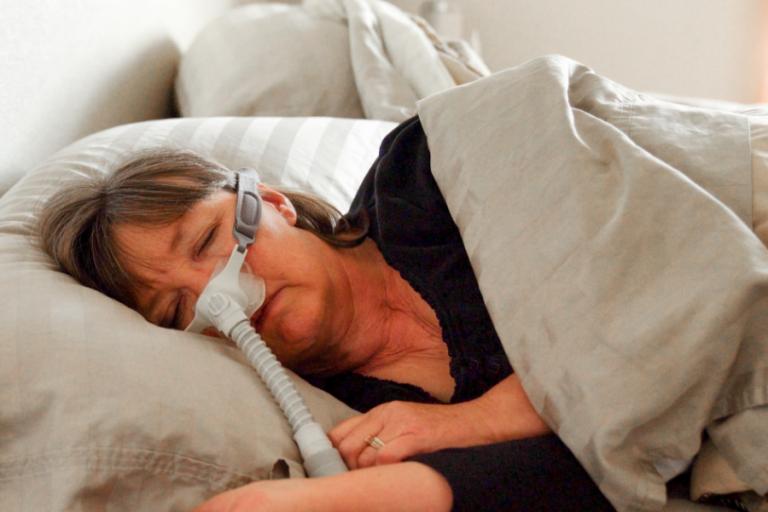How To Identify Risk Factors For Developing Sleep Apnea?

Sleep apnea is a common sleep disorder characterized by repeated interruptions in breathing during sleep. Identifying the risk factors for developing this condition is crucial for prevention and early intervention. This article aims to provide an objective and impersonal overview of the various risk factors associated with sleep apnea.
Lifestyle habits play a significant role in the development of sleep apnea. Factors such as obesity, smoking, excessive alcohol consumption, and sedentary behavior have been linked to an increased risk of developing this disorder.
Additionally, certain medical conditions, including hypertension, diabetes, and cardiovascular diseases, have been identified as potential risk factors for sleep apnea.
Anatomical characteristics, such as a narrow airway or enlarged tonsils, can also contribute to the development of sleep apnea. Moreover, family history has been shown to play a role, suggesting a genetic predisposition to the condition. Age and gender are additional risk factors, with sleep apnea being more prevalent in older individuals and males.
Hormonal changes, such as those occurring during menopause, may increase the risk of sleep apnea in women. Furthermore, ethnicity has been identified as a potential risk factor, with certain populations being more susceptible to the disorder.
By understanding and recognizing these risk factors, healthcare professionals can identify individuals who may be at a higher risk of developing sleep apnea. Early identification and intervention can significantly improve outcomes and quality of life for those affected by this sleep disorder.
Key Takeaways
- Obesity, smoking, excessive alcohol consumption, sedentary behavior, hypertension, diabetes, cardiovascular diseases, anatomical characteristics, family history, genetic predisposition, age, gender, hormonal changes during menopause, and certain ethnicities are all risk factors for sleep apnea.
- Lifestyle habits such as smoking, excessive alcohol consumption, and obesity contribute to the development of sleep apnea.
- Anatomical factors such as a narrow airway, enlarged tonsils, and adenoids can obstruct the flow of air and increase the risk of sleep apnea.
- Ethnicity plays a role in sleep apnea prevalence, with certain ethnic groups having a higher risk, such as African, Hispanic, Pacific Islander, and Southeast Asian populations.
Lifestyle Habits
Lifestyle habits play a crucial role in identifying risk factors associated with the development of sleep apnea. Various lifestyle factors have been found to contribute to the increased likelihood of developing this sleep disorder. One such habit is smoking, as it has been strongly associated with the incidence and severity of sleep apnea. Smoking leads to inflammation and swelling in the upper airway, which can further obstruct the flow of air during sleep.
Another lifestyle habit that has been linked to sleep apnea is excessive alcohol consumption. Alcohol relaxes the muscles in the throat and can lead to increased episodes of apnea during sleep.
Additionally, a sedentary lifestyle and obesity have also been identified as significant risk factors for developing sleep apnea. These lifestyle habits should be considered when assessing an individual’s risk of sleep apnea and implementing preventive measures.
Medical Conditions
Medical conditions such as obesity, hypertension, and diabetes have been associated with an increased likelihood of developing the condition characterized by pauses in breathing during sleep, known as sleep apnea. These medical conditions can contribute to the development of sleep apnea by affecting the airways or respiratory system.
- Obesity: Excess weight can lead to the accumulation of fat around the neck and throat, narrowing the airways and making it difficult to breathe during sleep.
- Hypertension: High blood pressure can cause the blood vessels in the respiratory system to constrict, increasing the risk of sleep apnea.
- Diabetes: Poorly controlled diabetes can lead to nerve damage and affect the muscles involved in breathing, contributing to sleep apnea.
- Other medical conditions: Certain conditions such as chronic nasal congestion, allergies, and smoking can also increase the risk of sleep apnea by interfering with normal breathing patterns during sleep.
Identifying these risk factors is crucial in the prevention, diagnosis, and management of sleep apnea, as addressing these underlying medical conditions may help alleviate symptoms and improve overall health.
Anatomical Characteristics
This paragraph discusses the anatomical characteristics associated with the development of sleep apnea.
One key point is obesity and excess fat in the neck area, which can lead to the narrowing of the airway and obstruction of airflow during sleep.
Another important factor is enlarged tonsils and adenoids, which can also contribute to airway blockage.
Additionally, a narrow airway passage can increase the likelihood of sleep apnea, as it may be more prone to collapse during sleep.
Obesity and Excess Fat in the Neck Area
Obesity and excess fat in the neck area have been identified as significant risk factors for developing sleep apnea. Studies have consistently shown a strong association between obesity and the development of sleep apnea, with increased body weight leading to an increased risk of developing the disorder.
The excess fat in the neck area can contribute to the narrowing of the upper airway, leading to breathing difficulties during sleep. This narrowing can result in blockages or partial blockages of the airway, causing the characteristic pauses in breathing that are characteristic of sleep apnea.
Furthermore, the accumulation of fat in the neck area can also increase the pressure on the airway, further exacerbating the breathing difficulties. Therefore, efforts to address obesity and reduce excess fat in the neck area can potentially help in reducing the risk of developing sleep apnea.
Enlarged Tonsils and Adenoids
Enlarged tonsils and adenoids have been recognized as significant contributors to the development of sleep apnea. These structures, located in the back of the throat, play a crucial role in maintaining a clear airway during sleep. When tonsils and adenoids become enlarged, they can obstruct the flow of air, leading to interruptions in breathing and ultimately causing sleep apnea.
Research has identified several possible risk factors for the enlargement of tonsils and adenoids, including:
- Chronic infections: Recurrent infections can cause inflammation and swelling of the tonsils and adenoids, leading to their enlargement.
- Allergies: Allergic reactions can also trigger inflammation in these structures, contributing to their enlargement.
- Genetic factors: Some individuals may be genetically predisposed to having larger tonsils and adenoids, increasing their risk of developing sleep apnea.
It is important for healthcare professionals to consider the role of enlarged tonsils and adenoids when evaluating patients for sleep apnea, as their removal can often alleviate symptoms and improve overall sleep quality.
Narrow Airway Passage
One of the risk factors for developing sleep apnea is a narrow airway passage. A narrow airway can make it more difficult for air to flow freely during sleep, leading to interruptions in breathing and the development of sleep apnea. This can be caused by a variety of factors, including structural abnormalities such as a small jaw, large tongue, or a narrowed throat. In addition, obesity and excessive weight around the neck can contribute to the narrowing of the airway.
To emphasize the impact of a narrow airway on sleep apnea, a 2 column and 3 row table can be used to compare the characteristics of a normal airway and a narrow airway. The table could include factors such as airway size, potential obstructions, and the likelihood of developing sleep apnea.
Family History
A significant factor in determining the likelihood of developing sleep apnea is a familial history of the condition, which can evoke concern and anxiety among individuals who have relatives with sleep apnea.
Studies have shown that there is a strong genetic component to sleep apnea, with a higher risk observed in individuals with a family history of the disorder. Research has identified several genes that are associated with sleep apnea, including those involved in the regulation of upper airway muscles, inflammation, and metabolism.
However, it is important to note that having a family history of sleep apnea does not guarantee that an individual will develop the condition. Other environmental and lifestyle factors, such as obesity and smoking, can also play a role in increasing the risk.
Therefore, it is crucial for individuals with a family history of sleep apnea to be aware of the potential risk and take proactive measures, such as maintaining a healthy lifestyle and seeking medical advice if symptoms arise.
Age
As individuals age, the prevalence of sleep apnea tends to increase, leading to a greater likelihood of experiencing disrupted sleep patterns and related health complications. Age is considered a significant risk factor for developing sleep apnea, with the condition becoming more common in middle-aged and older adults. This can be attributed to various changes that occur in the body over time, such as decreased muscle tone in the throat and airway, increased likelihood of weight gain, and changes in hormonal levels.
To emphasize the impact of age on sleep apnea risk, consider the following:
- Middle-aged adults are more likely to develop sleep apnea compared to younger individuals.
- The risk of sleep apnea further increases with advancing age.
- Older adults are more likely to experience severe sleep apnea symptoms and associated health complications.
Understanding the relationship between age and sleep apnea risk is crucial for effective prevention, early detection, and management of the condition in older populations.
Gender
Gender differences play a significant role in the prevalence and severity of sleep apnea. Studies have shown that men are more likely to develop sleep apnea compared to women. This gender disparity may be due to anatomical differences, hormonal factors, and lifestyle choices.
Anatomically, men tend to have a higher body mass index (BMI), larger neck circumference, and more collapsible upper airways, which can increase the risk of developing sleep apnea. Hormonal factors, such as the decrease in estrogen levels during menopause, may also contribute to the higher prevalence of sleep apnea in women.
Additionally, lifestyle choices such as smoking and alcohol consumption, which are more prevalent among men, have been associated with an increased risk of sleep apnea. Understanding these gender differences is crucial in identifying individuals at risk for developing sleep apnea and implementing targeted prevention and treatment strategies.
Hormonal Changes
Hormonal changes, particularly the decrease in estrogen levels during menopause, are believed to contribute to the higher prevalence of sleep apnea in women. Estrogen has been shown to have a protective effect on the upper airway, promoting muscle tone and maintaining airway patency. As estrogen levels decline, the upper airway muscles become more lax, leading to an increased risk of airway collapse during sleep.
Additionally, hormonal changes can affect sleep architecture, resulting in disrupted sleep patterns and increased arousal thresholds, further exacerbating sleep apnea symptoms. The association between hormonal changes and sleep apnea is further supported by studies showing that hormone replacement therapy in postmenopausal women can improve sleep apnea symptoms.
However, more research is needed to fully understand the complex relationship between hormonal changes and sleep apnea in women.
Ethnicity
Ethnicity is another important factor that has been linked to the risk of developing sleep apnea. Research studies have shown that certain ethnic groups are more susceptible to this sleep disorder than others. For example, individuals of African, Hispanic, and Pacific Islander descent have been found to have a higher prevalence of sleep apnea compared to Caucasians. Additionally, Asian populations, particularly those from Southeast Asia, have been found to have a higher risk of developing sleep apnea.
The exact reasons for these disparities are not fully understood, but it is believed that genetic and anatomical factors, as well as differences in lifestyle and cultural practices, may play a role. Understanding the relationship between ethnicity and sleep apnea can help in identifying individuals who may be at a higher risk and implementing appropriate preventive measures.
Markdown list to evoke emotion in the audience:
- Increased risk of sleep apnea due to ethnicity can lead to disparities in health outcomes.
- Ethnic minority groups may face challenges in accessing appropriate diagnosis and treatment for sleep apnea.
- Sleep apnea can have a significant impact on the overall well-being and quality of life of affected individuals.
- Raising awareness about the impact of ethnicity on sleep apnea can help in addressing healthcare disparities and promoting equal access to care.
Frequently Asked Questions
What are the lifestyle habits that can contribute to the development of sleep apnea?
Lifestyle habits such as obesity, smoking, alcohol consumption, and sedentary behavior have been associated with an increased risk of developing sleep apnea. These factors can contribute to the development of the condition by affecting upper airway muscles and promoting airway collapse during sleep.
What medical conditions are commonly associated with sleep apnea?
Medical conditions commonly associated with sleep apnea include obesity, hypertension, diabetes, cardiovascular diseases, and stroke. These conditions are often seen as risk factors for developing sleep apnea and may contribute to its onset and severity.
What are some common anatomical characteristics that may increase the risk of developing sleep apnea?
Common anatomical characteristics that may increase the risk of developing sleep apnea include obesity, a narrow throat or airway, a large tongue or tonsils, a recessed jaw, and a family history of the condition.
How does family history play a role in the development of sleep apnea?
Family history is a significant risk factor for sleep apnea. Studies have shown that individuals with a family history of the condition are more likely to develop sleep apnea themselves, suggesting a genetic predisposition.
Are there any specific age groups or genders that are more prone to developing sleep apnea?
There is evidence to suggest that older age and male gender are risk factors for developing sleep apnea. However, further research is needed to establish a definitive link between specific age groups or genders and the development of sleep apnea.











